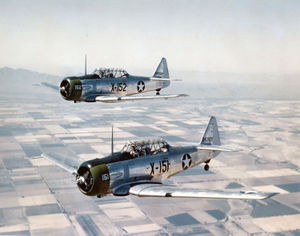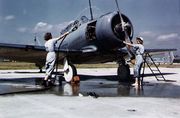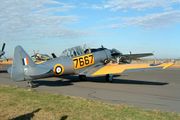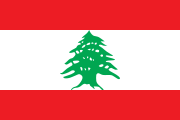North American T-6 Texan
| T-6 Texan/SNJ/Harvard | |
|---|---|
 |
|
| USAAF AT-6Cs near Luke Field, 1943 | |
| Role | Trainer aircraft |
| Manufacturer | North American Aviation |
| First flight | 1 April 1935 |
| Primary users | United States Army Air Forces United States Navy Royal Air Force |
| Number built | 15,495 |
| Developed from | North American NA-16 |
| Variants | North American A-27 I.Ae. D.L. 22 |
01.jpg)

The North American Aviation T-6 Texan was a single-engine advanced trainer aircraft used to train pilots of the United States Army Air Forces, United States Navy, Royal Air Force and other air forces of the British Commonwealth during World War II and into the 1950s. Designed by North American Aviation, The T-6 is known by a variety of designations depending on the model and operating air force. The USAAC designated it as the "AT-6", the US Navy the "SNJ", and British Commonwealth air forces, the Harvard, the name it is best known by outside of the United States. It remains a popular warbird aircraft.
Contents |
Development
The Texan originated from the North American NA-16 prototype (first flown on April 1, 1935) which, modified as the NA-26, was submitted as an entry for a USAAC "Basic Combat" aircraft competition in March, 1937. The first model went in to production and 180 were supplied to the USAAC as the BC-1 and 400 to the RAF as the Harvard I. The US Navy received 16 modified aircraft, designated the SNJ-1, and a further 61 as the SNJ-2 with a different engine.
The BC-1 was the production version of the NA-26 prototype, with retractable tailwheel landing gear and the provision for armament, a two-way radio, and the 550 hp (410 kW) R-1340-47 engine as standard equipment. Production versions included the BC-1 (Model NA-36) with only minor modifications (177 built), of which 30 were modified as BC-1I instrument trainers; the BC-1A (NA-55) with airframe revisions (92 built); and a single BC-1B with a modified wing center-section.
Three BC-2 aircraft were built before the shift to the "advanced trainer" designation, AT-6, which was equivalent to the BC-1A. The differences between the AT-6 and the BC-1 were new outer wing panels with a swept forward trailing edge, squared-off wingtips and a triangular rudder, producing the definitive Texan appearance. After a change to the rear of the canopy, the AT-6 was designated the Harvard II for RAF/RCAF orders and 1,173 were supplied by purchase or Lend Lease, mostly operating in Canada as part of the British Commonwealth Air Training Plan.
Next came the AT-6A which was based on the NA-77 design and was powered by the Pratt & Whitney R-1340-49 Wasp radial engine. The USAAF received 1,549 and the US Navy 270 (as the SNJ-3). The AT-6B was built for gunnery training and could mount a .30 in machine gun on the forward fuselage. It used the R-1340-AN-1 engine, which was to become the standard for the remaining T-6 production. Canada's Noorduyn Aviation built an R-1340-AN-1-powered version of the AT-6A, which was supplied to the USAAF as the AT-16 (1,500 aircraft) and the RAF/RCAF as the Harvard IIB (2,485 aircraft), some of which also served with the Fleet Air Arm and Royal Canadian Navy.
In late 1937 Mitsubushi purchased two NA-16s as technology demonstrators and possibly a licence to build more. However, the aircraft developed by Watanabe/Kyushu as the K10W1 (Allied code name Oak) bore no more than a superficial resemblance to the North American design. It featured a full monocoque fuselage as opposed to the steel tube fuselage of the T-6 and NA-16 family of aircraft, as well as being of smaller dimensions overall and had no design details in common with the T-6. It was used in very small numbers by the Imperial Japanese Navy from 1942 onwards. After the war the Japanese Air Self Defense Force operated Texans.
The NA-88 design resulted in 2,970 AT-6C Texans and 2,400 as the SNJ-4. The RAF received 726 of the AT-6C as the Harvard IIA. Modifications to the electrical system produced the AT-6D (3,713 produced) and SNJ-5 (1,357 produced). The AT-6D, redesignated the Harvard III, was supplied to the RAF (351 aircraft) and Fleet Air Arm (564 aircraft). The AT-6G (SNJ-5) involved major advancements including a full-time hydraulic system and a steerable tailwheel and persisted into the 1950s as the USAF advanced trainer.
Subsequently the NA-121 design with a completely clear rearmost section on the canopy, gave rise to 25 AT-6F Texans for the USAAF and 931, as the SNJ-6 for the US Navy. The ultimate version, the Harvard 4, was produced by Canada Car and Foundry during the 1950s, and supplied to the RCAF, USAF and Bundeswehr.
A total of 15,495 T-6s of all variants were built.
Operational history
During the Korean War and, to a lesser extent, the Vietnam war, T-6s were pressed into service as forward air control aircraft. These aircraft were designated T-6 "Mosquitos".[1] No. 1340 Flight RAF used the Harvard in Kenya against the Mau Mau in the 1950s, where they operated with 20 lb bombs and machine guns against the gangs. Some operations took place at altitudes around 20,000 ft above mean sea level. A Harvard was the longest-serving RAF aeroplane, with an example, taken on strength in 1945, still serving in the 1990s (as a chase plane for helicopter test flights - a role for which the Shorts Tucano's high stall speed was ill-suited). The T-6G was also used in a light attack or counter insurgency role by France during the Algerian war in special Escadrilles d'Aviation Légère d'Appui (EALA), armed with machine guns, bombs and rockets. At its peak, there were 38 EALAs active. The largest unit was the Groupe d'Aviation Légère d'Appui 72, which consisted of up to 21 EALAs. From 1961 to 1975, Portugal, also, used hundreds of T-6G in the counter insurgency role during the Portuguese Colonial War. During this war, almost all the Portuguese Air Force bases and air fields in Angola, Mozambique and Portuguese Guinea had a detachment of T-6Gs. In 1957-58, the Spanish Air Force used T-6 as COIN aircraft in the Ifni War, armed with machine guns, iron bombs and rockets, achieving an excellent reputation due to its reliability, safety record and resistance to damage.
Since the Second World War, the T-6 has been a regular participant at air shows, and was used in many movies. For example, in Tora! Tora! Tora! and The Final Countdown, converted single-seat T-6s painted in Japanese markings represent Mitsubishi Zeroes, whereas in A Bridge too Far it represented the razorback Republic P-47 Thunderbolt. The New Zealand Warbirds "Roaring 40s" aerobatic team use ex-Royal New Zealand Air Force Harvards. The Reno National Air Races also has a class specifically for the T-6 during the National Air Races each year.
Due mainly to the United Nations arms embargo against South Africa's Apartheid policies, T-6s remained in service with the South African Air Force as a basic trainer until 1995, when they were replaced by Pilatus PC-7MkII turboprop trainers.[2]
Variants
Operators








- Argentine Naval Aviation
- Austrian Air Force
- Belgian Air Force
- Bolivian Air Force
- Naval Aviation
- Royal Canadian Air Force
- Royal Canadian Navy
- National Research Council
- Republic of China Air Force
- Chilean Air Force
- Colombian Air Force
- Congolese Air Force
- Royal Danish Air Force
- Dominican Air Force
- Air Force of El Salvador
- Gabon Air Force
- Hellenic Air Force
- Armed Forces of Haiti
- Royal Hong Kong Auxiliary Air Force
- Honduran Air Force
- Royal Indian Air Force
- Indian Air Force
- Indonesian Air Force - ex-Dutch aircraft.
- Iranian Air Force
- Aeronautica Militare
- Japan Air Self-Defense Force
 Katanga
Katanga Lebanon
Lebanon
- Lebanese Air Force
- Republic of Korea Air Force
- Royal Laotian Air Force
- Mexican Air Force
- Royal Moroccan Air Force
- Royal Netherlands Air Force
- Dutch Naval Aviation Service
- Royal Netherlands East Indies Army Air Force - Post war
- Mozambique Air and Air Defense Forces
- Royal Norwegian Air Force
- Nicaraguan Air Force
- Paraguayan Air Force
- Paraguayan Naval Aviation
- Philippine Air Force
- Portuguese Air Force
- Portuguese Navy
- South African Air Force
- Southern Rhodesian Air Force
- Vietnam Air Force
- Swedish Air Force
- Syrian Air Force
- Royal Thai Air Force
- Tunisian Air Force
- Turkish Air Force: 196 planes of various types
- United States Army Air Corps/Army Air Forces
- United States Air Force
- United States Navy
- United States Marine Corps
- United States Coast Guard
- Uruguayan Air Force
- Venezuelan Air Force
- SFR Yugoslav Air Force
Specifications (T-6G)

Data from Jane’s Fighting Aircraft of World War II[3]
General characteristics
- Crew: two (student and instructor)
- Length: 29 ft (8.84 m)
- Wingspan: 42 ft (12.81 m)
- Height: 11 ft 8 in (3.57 m)
- Wing area: 253.7 ft² (23.6 m²)
- Empty weight: 4,158 lb (1,886 kg)
- Loaded weight: 5,617 lb (2,548 kg)
- Powerplant: 1× Pratt & Whitney R-1340-AN-1 Wasp radial engine, 600 hp (450 kW)
Performance
- Maximum speed: 208 mph at 5,000 ft (335 km/h at 1,500 m)
- Cruise speed: 145 mph (233 km/h)
- Range: 730 miles (1,175 km)
- Service ceiling: 24,200 ft (7,400 m)
- Rate of climb: ft/min (m/s)
- Wing loading: lb/ft² (kg/m²)
- Power/mass: hp/lb (kW/kg)
Armament
- Provision for up to 3× 0.30 in (7.62 mm) machine gun
See also
- T-6 Texan II
Related development
- North American NA-16
- North American BT-9
- North American BC-1
- North American A-27
- North American P-64
- CAC Wirraway
- I.Ae. D.L. 22
- Kyūshū K10W
Comparable aircraft
- Miles Master
Related lists
- List of military aircraft of the United States
- List of military aircraft of the United States (naval)
- List of aircraft of the RAF
- List of aircraft of the RNZAF
References
Notes
- ↑ AF Museum - North American T-6D "Mosquito"
- ↑ http://www.af.mil.za/about_us/history.html#7
- ↑ Bridgeman, Leonard. “The North American Texan.” Jane's Fighting Aircraft of World War II. London: Studio, 1946.. p. 251. ISBN 1 85170 493 0.
Bibliography
- Becker, Dave and Brent, Winston. AT-6 Harvard in South African Service (African Aviation Series No.1). Nelspruit, South Africa:, Freeworld Publications CC, 2000. ISBN 0-95838-802-4.
- Bergése, Francis. North American T-6 (in French). Rennes, France: Ouest France, 1979. ISBN 2-85882-183-6.
- Davis, Larry. T-6 Texan in Action (Aircraft Number 94). Carrollton, TX: Squadron/Signal Publications, Inc., 1989. ISBN 0-89747-224-1.
- Donald, David. American Warplanes of World War II. London:Aerospace Publishing, 1995. ISBN 1 874023 72 7.
- Fletcher, David C. and MacPhail, Doug. Harvard! the North American Trainers in Canada. San Josef,BC/Dundee,Ont: DCF Flying Books, 1990. ISBN 0-96938-250-2.
- Hagedorn, Dan. North American NA-16/AT-6/SNJ (WarbirdTech Volume 11). North Branch, MN: Speciality Press, 1997. ISBN 0-93342-476-0.
- Hamlin, John F. The Harvard File. Tonbridge, Kent, UK: Air-Britain (Historians) Ltd., 1988. ISBN 0-85130-160-6.
- Jesse. William. T-6 Texan, the Immortal Pilot Trainer. London: Osprey Publishing Ltd., 1991. ISBN 1-85532-154-8.
- Kohn, Leo J. The Story of the Texan (American Flight Manuals). Aviation Publications Co., 1975. ISBN 0-87994-034-4.
- MacPhail, Doug and Östberg, Mikael. Triple Crown BT-9: The ASJA/Saab Sk 14, A Pictorial Essay (in English/Swedish). San Josef,BC/Dundee,Ont: DCF Flying Books, 2003.
- Marchand, Patrick and Takamori, Junko. North American T-6 et derives (in French). Le Muy, France: Editions d’Along, 2004. ISBN 2-914403-21-6.
- Morgan, Len. Famous Aircraft Series: The AT-6 Harvard. New York: Arco Publishing Co., Inc., 1965.
- Olrich, Walter and Ethell, Jeffrey L. Pilot maker; the Incredible T-6. North Branch, MN: Specialty Press, 1982. ISBN 0-93342-434-5.
- Smith, Peter Charles. North American T-6: SNJ, Harvard and Wirraway. Ramsbury, Marlborough, Wiltshire, UK: The Crowood Press Ltd., 2000. ISBN 1-86126-382-1.
- Smith, Peter Charles. T-6: The Harvard, Texan & Wirraway - A Pictorial Record. North Branch, MN: Speciality Press, 1995. ISBN 0-7603-0191-3.
- Spring, Ivan and Rivers, Reg. Colour schemes and special markings of the North American "Harvard" in service with the SAAF 1940 to 1995. Pretoria, SOuth Africa: Spring Air Publishers, 1996. ISBN 0-9583977-3-2.
- Starkings, Peter. From American Acorn to Japanese Oak - The tale of an unsung Japanese training aircraft with roots extending across the Pacific Ocean. Arawasi International, Asahi Process, September-December 2007, Issue 7.
- Swanborough, Gordon and Bowers, Peter M. United States Military Aircraft since 1909. London:Putnam, 1963.
- Wache, Siegfried. CCF Harvard Mk. IV (T-6) (series F-40 - Die Flugzeuge der Bundeswehr Nr.09) (in German). Buchholz, Germany: Buchholz Medien Verlag, 1989. ISBN 3-935761-09-0.
External links
- The Canadian Harvard Aircraft Association
- Backgrounder on the Harvard 4 (includes photographs)
- AT-6: School Marm With an Attitude (pilot report)
- Warbird Alley: T-6/SNJ/Harvard page - History, photos, specs, and links
|
||||||||||||||||||||||||||||||||||||||||||||||||||||||||||||||||||||||||||||||||||||||||||||||||||||||||||||||||||||||||||||||||||||||||||||||||||||||||||||||||||||||||||||
|
||||||||||||||